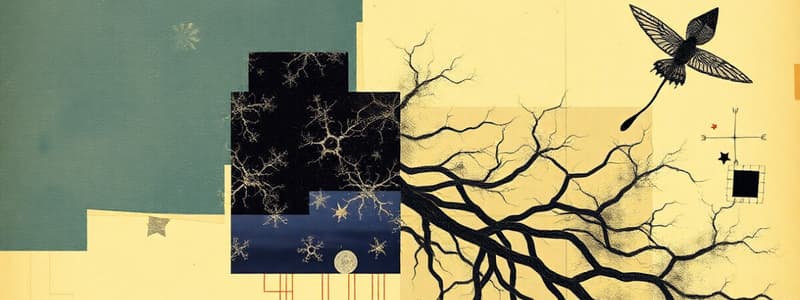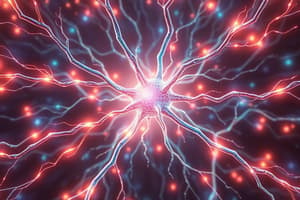Podcast
Questions and Answers
What is the name of the structure in the peripheral nervous system (PNS) that is analogous to a nucleus in the central nervous system (CNS)?
What is the name of the structure in the peripheral nervous system (PNS) that is analogous to a nucleus in the central nervous system (CNS)?
- Axon
- Ganglion (correct)
- Synapse
- Dendrite
Which of these neurotransmitters is NOT typically associated with inhibitory function in the nervous system?
Which of these neurotransmitters is NOT typically associated with inhibitory function in the nervous system?
- Glycine
- GABA
- Glutamate (correct)
- Dopamine
Which of the following accurately describes the three main anatomical planes of the brain?
Which of the following accurately describes the three main anatomical planes of the brain?
- Transverse, Sagittal, Coronal
- Sagittal, Coronal, Horizontal (correct)
- Coronal, Axial, Sagittal
- Sagittal, Axial, Transverse
What is the primary function of cerebrospinal fluid (CSF) in the brain?
What is the primary function of cerebrospinal fluid (CSF) in the brain?
Which of the following structures is NOT a component of the brainstem?
Which of the following structures is NOT a component of the brainstem?
Which of the following is NOT a function of the cerebrospinal fluid (CSF)?
Which of the following is NOT a function of the cerebrospinal fluid (CSF)?
Which of the following accurately describes the role of the diencephalon in the nervous system?
Which of the following accurately describes the role of the diencephalon in the nervous system?
What is the main function of the myelinated axons in the white matter of the CNS?
What is the main function of the myelinated axons in the white matter of the CNS?
Which of the following accurately describes the difference between ionotropic and metabotropic receptors in the nervous system?
Which of the following accurately describes the difference between ionotropic and metabotropic receptors in the nervous system?
During repolarization of a neuron, which of the following events occurs?
During repolarization of a neuron, which of the following events occurs?
Which of the following structures is derived from neural crest cells during embryonic development?
Which of the following structures is derived from neural crest cells during embryonic development?
Which of the following imaging techniques is best suited for visualizing swelling in the brain?
Which of the following imaging techniques is best suited for visualizing swelling in the brain?
Which of the following best represents the main function of the somatic nervous system?
Which of the following best represents the main function of the somatic nervous system?
Flashcards
Central Nervous System (CNS)
Central Nervous System (CNS)
The CNS consists of the brain and spinal cord.
Grey Matter
Grey Matter
Contains neuronal cell bodies and is found in the CNS.
White Matter
White Matter
Composed of myelinated axons, facilitating communication in the CNS.
Meninges
Meninges
Signup and view all the flashcards
Action Potential Generation
Action Potential Generation
Signup and view all the flashcards
Somatic Nervous System
Somatic Nervous System
Signup and view all the flashcards
Ionotropic Receptors
Ionotropic Receptors
Signup and view all the flashcards
Metabotropic Receptors
Metabotropic Receptors
Signup and view all the flashcards
Glutamate
Glutamate
Signup and view all the flashcards
GABA
GABA
Signup and view all the flashcards
Projection neurons
Projection neurons
Signup and view all the flashcards
Ventricular system
Ventricular system
Signup and view all the flashcards
Study Notes
Central Nervous System (CNS)
- The CNS comprises the brain and spinal cord
- Grey matter contains neuronal cell bodies
- White matter contains myelinated axons
- Meninges are protective layers of the CNS
Peripheral Nervous System (PNS)
- The PNS connects the CNS to the rest of the body
- It comprises all nerves outside the CNS
Action Potential Generation
- Resting potential: Neuron is polarized
- Stimulus causes depolarization
- Threshold: Voltage-gated Na+ channels open if reached
- Rapid depolarization: Na+ influx
- Repolarization: K+ channels open, K+ exits
- Hyperpolarization: Briefly more negative, then return to resting potential
Ventricular System
- Protects the CNS by producing CSF
- Cushions the brain and spinal cord
- Maintains pressure
Somatic Nervous System
- Responsible for voluntary movements
Nervous System Function
- Integrates the internal state of the body with the environment to guide behavior
Neurotransmitters
- Glutamate is a main excitatory neurotransmitter of projection neurons
- GABA (Gamma-Aminobutyric Acid) is typically inhibitory
- Dopamine can be either excitatory or inhibitory depending on receptor type
Synapses
- Allow neurons to transmit signals to other neurons or effectors
Brain Structures
- Brainstem is part of the CNS
- Dura, arachnoid, and pia mater form the meninges that protect the CNS.
- Sagittal, Coronal, and Axial (Horizontal) are the three main anatomical orientation planes of the brain
- The neural tube gives rise to the nervous system
- Projection neurons transmit signals over long distances in the nervous system
- Ganglion is equivalent to "nucleus" in the PNS
- Ventricular system circulates cerebrospinal fluid (CSF) for cushioning and nutrient transport.
- Brainstem consists of the Medulla, Pons, and Midbrain
Autonomic Nervous System (ANS)
- Two main divisions: Sympathetic and parasympathetic
- Sympathetic division is responsible for the "fight or flight" response.
Studying That Suits You
Use AI to generate personalized quizzes and flashcards to suit your learning preferences.




